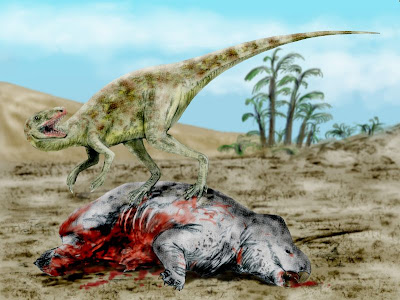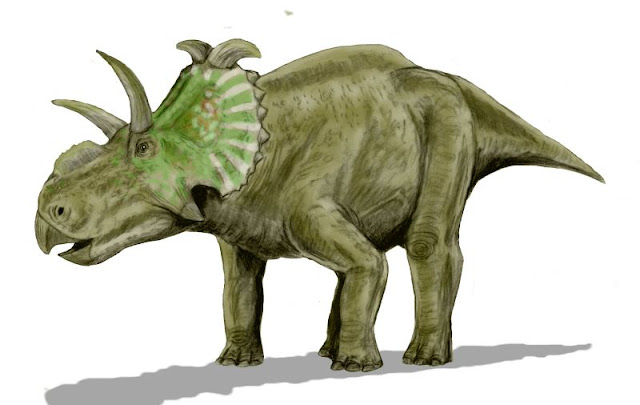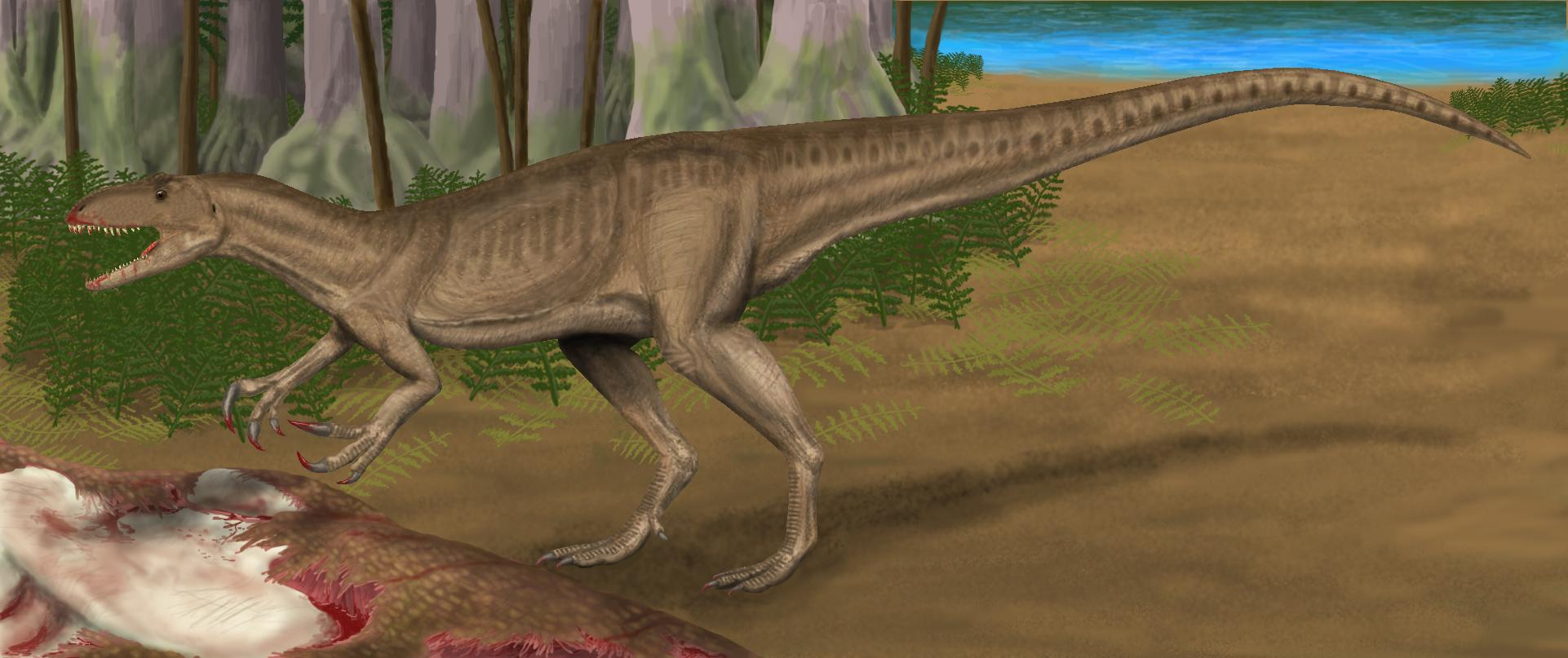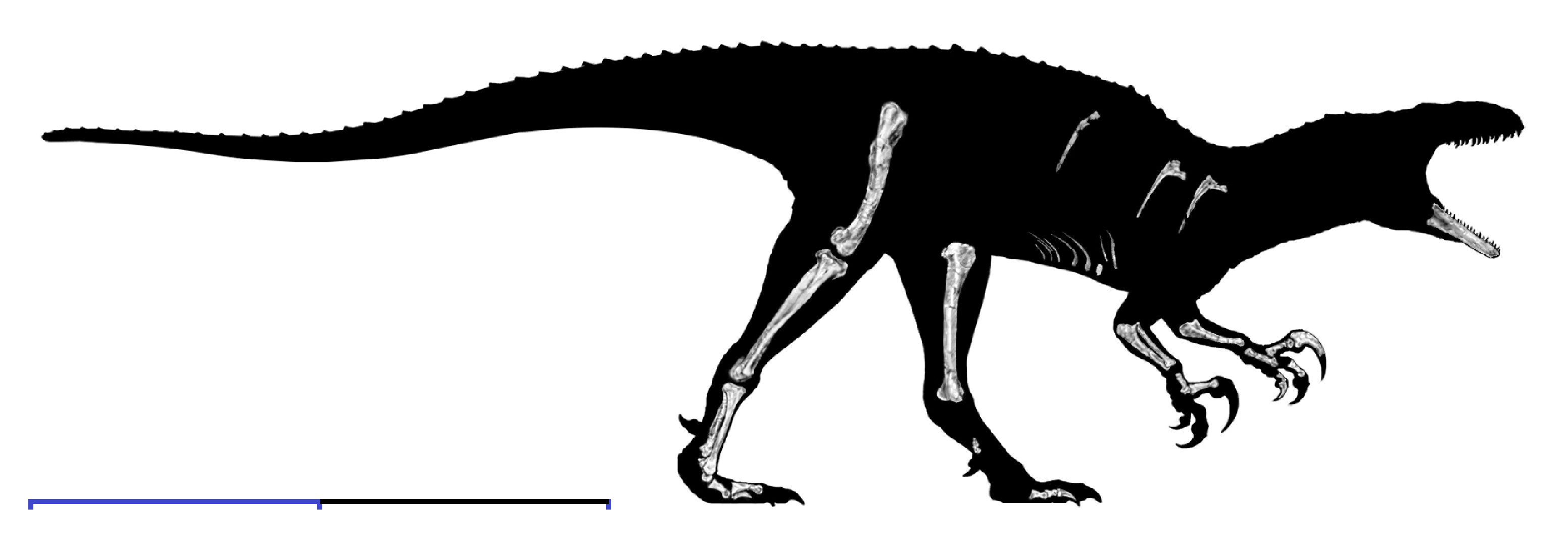 |
| Japan loves dinosaurs! |
↧
Panoplosaurus the Loved
↧
Journeys in the Triassic
We have not been to the Triassic in a good long while, but today we shall venture back there. Herrerasaurids are some of the earliest theropods and, arguably, some of the least understood still. Often this is due to incomplete fossil finds, such as the animal that will be discussed this week. However, a good portion of the post-cranial skeleton of this dinosaur has been recovered in Brazil, of all the places in South America. Typically when we here "dinosaur" and "South America" in the same sentence we typically think of Argentina and Jose Bonaparte. However, Staurikosaurus pricei was named by Edwin Colbert, born in Iowa, and more renowned for having a hand in the discoveries of Ghost Ranch, New Mexico, a lot of systematics work, and his work in Antarctica, just to name a sliver of the things he accomplished during his 96 years of life. Colbert's name for this 225 million year old agile bipedal predator translates to "Southern Cross Lizard" with the specific epithet being in honor of Brazilian paleontologist Llewellyn Ivor Price, who had actually collected the fossil. The fossil, as stated, is made up of quite a good portion of the post-cranial skeleton as well as the mandible. Hindlimbs, the pelvic girdle, and the vertebral column are nearly complete; however, the feet and forelimbs, ribs and cranial elements other than the mandible are lacking. All told, animals have been named on far less and the bones present indicate a predator that, at about 66lbs (30kg), 31in (80cm) tall, and 7.4ft (2.3m) long, was about the weight of the average Labrador Retriever but just a tad taller (and obviously longer). The remains that have been discovered and the primitive age of this dinosaur, however, have led to some educated guesses pertaining to the make up of the missing skeletal elements. Chief amongst these are depictions of the hands and feet of Staurikosaurus as five fingered and toed basal appendages. The running speed of Staurikosaurus, despite the primitive foot and pelvic girdle, is considered to be fairly quick given the structure of the legs. The long tail consisting of approximately 40 caudal vertebrae would have aided the quick little dinosaur in maintaining its balance at its higher speeds.
↧
↧
The Completed Incomplete Skeleton
 |
| Oscar Alcober, Ricardo Martinez; retrieved from Wikipedia |
 |
| ©Dmitry Bogdanov |
 |
| ©Nobu Tamura |
↧
Staurikosaurus for Kids
Staurikosaurus has links for kids, which is pretty neat for a little understood early dinosaur. Thankfully, the Dinosaurs for Kids site has a nice quality page that is easy for kids to garner information from. Coloring pages are a little bit lacking, but that may have more to do with the fact that Staurikosaurus is still a little known dinosaur. The Dino Directory from the Natural History Museum of London also has a page set up for some facts that are easy for kids to read. Their size chart looks a little bit off, though; the Staurikosaurus is a bit larger than it probably should be.
↧
Fun with Art Snippets
Staurikosaurus, the Triassic dinosaur, is, as we noted, somewhat popular. That has led to a couple "tribute" videos as well as some video game references. As usual, not every single image in the tribute videos that pop up from time to time on the internet are carefully reviewed and are therefore not certainly the dinosaur in question. However, given that a good amount of skeletal material is missing from the discovered remains the illustrated versions of this dinosaur are, as we have seen, highly open to interpretation by the artist in terms of the exact reconstruction of those missing elements of the skeleton. That, then, leads us to these tribute videos that are widely open in their own interpretation of the dinosaur they are showing. There is an amount of fault of the people that create the videos in not finding images of the animal correctly or, worse, accepting every labeled animal they see as an authentic representation of that dinosaur. Some of that incorrectness is always found in these videos, but generally we can look beyond it. Though I know that I have had to edit posts from time to time, it concerns me a little more when these videos are massively incorrect in what they represent because sites like YouTube have such heavy traffic; though we can probably assume that a third of the traffic on the site is directed at a minority of the videos on there. Regardless, it is nice that the video has been posted and has views because it means that someone is interested in Staurikosaurus.
↧
↧
DIscovering Staurikosaurus
Staurikosaurus was named in 1970 and discovered a while before that; 1936 to be exact. Edwin Colbert, the American that named the dinosaur, had the fortune of having the specimen loaned to him for study. His description and comparison with other materials lead to the discovery that this "archosaurian reptile" was one of the earlier dinosaurs of the Triassic. He named his new discovery after the Southern Cross, a constellation, and after the man responsible for the collection of this and many other discoveries in the Brazilian Triassic soils. His initial description of the material is very in depth and contains some nice plates; there is a combination of illustrations and photographs in the paper. Another paper which may warrant attention is a slightly newer paper by D.B. Brinkman and Hans-Dieter Sues. Their paper identifies and describes a Staurikosaurus sp. from Argentina's Ischigualasto formation. They also describe the relationships between Herrarasaurus and Staurikosaurus as sister taxa as well as confirm the placement of Staurikosaurus within the dinosaurs. There are a few other papers out there, but I think these two are good for one day as they are both a bit heavily detailed.
↧
The Tidbits on Hand
A great deal of paleontology is often done, and we have seen this many times over, with fragmentary evidence. Sometimes, as we have seen, little more than a few phalanges are discovered in any one dig and, sometimes, these very few bones are used to identify an entire animal. That is by no means impossible, but some remains' identifications seem quite improbable. Luckily for Staurikosaurus its initial skeletal remains were enough to justify a new species even though they were still fragmentary enough to still have detractors. Both sides of the arguments would make sense if we step back and look at the evidence from each viewpoint. On the one hand we have a fairly clearly early theropod dinosaur that has very few derived characters but enough to justify its classification as a primitive dinosaur rather than just another archosaur. The opposite view, while not popular or even represented to my knowledge at present, would hold that Staurikosaurus is simply an archosaur that lived alongside dinosaurs or just prior to the earliest dinosaurs. The defining line between archosaur and dinosaur sometimes gets fuzzy (depending on the source of the definition), so any confusion of the placement of Staurikosaurus is probably due to this grey area. Just for our purposes, we can treat archosauria as a crown group that contains only extant animals such as crocodiles and birds. Thus Staurikosaurus being considered a dinosaur means that it is not a bird or a crocodile, in the simplest of terms; one can see where the confusion occurs. Regardless, Staurikosaurus possesses some very nice basal dinosaur traits such as its minimal sacral vertebrae (only 2 exist) and elongated cervical vertebrae. Despite being as basal as Staurikosaurus is, it is thought to have evolved in the theropod line after sauropods had already begun to evolve differently in the saurischian branch. Staurikosaurus and its sister taxa (Herrerasaurus chiefly) certainly warrant more investigation than I have given here this week. Hopefully very soon even more material will be discovered (in Argentina or Brazil) and more studies can be conducted. Not really my cup of tea as far as an academic project is concerned though, so it probably will not be my thesis work!
↧
Game Popularity
Surprisingly, or perhaps not, Staurikosaurus has appeared in a few video games. Granted those in Spore videos are made by the people that put them into the game, it still counts. The enterprising video that I have included here even gave Staurikosaurus some offspring and, presumably, the parental care genes that keep this individual from eating its offspring. That is a pretty powerful assumption to make for pretty much any animal (any animal without the human ethical code at least anyhow; take that Swift). All kidding aside, this Spore creation deserves some pretty high praise given its accuracy for the remains we have and the fact that the person that created this had the imagination, or maybe knowledge, to create offspring that are fairly believable as well as the parenting instinct to not eat the little creatures. I am pretty sure creatures "eat" each other all the time in the Spore universe, so that is a pretty tall order in and of itself.
Additionally, Staurikosaurus shows up in other video games such as this Dinosaur Safari clip. Strangely enough, I have to say, the Zoo Tycoon people at Microsoft have always gone with Herrerasaurus rather than Staurikosaurus, which is okay, but somewhat sad based on the fact that people that play it, like me, love variety in our dinosaurs. Apparently, and I did not find this Monday for movie day, Staurikosaurus has also made an appearance in a documentary I have not heard of called Animal Armageddon. Considering the fact that I watch everything that ever comes out about dinosaurs no matter the accuracy, it is pretty rare that I have not heard of a dinosaur documentary. I should put out a caveat to myself though; I have not had cable/satellite television since 2006 in my home, so sometimes I learn about things a ways after they are out on television. Regardless, the episode in which Staurikosaurus appears is on YouTube. There are no toys to speak of and, very sadly, no plush or crochet toys (like last week). Staurikosaurus is clearly fairly popular though, and that is a start.
Additionally, Staurikosaurus shows up in other video games such as this Dinosaur Safari clip. Strangely enough, I have to say, the Zoo Tycoon people at Microsoft have always gone with Herrerasaurus rather than Staurikosaurus, which is okay, but somewhat sad based on the fact that people that play it, like me, love variety in our dinosaurs. Apparently, and I did not find this Monday for movie day, Staurikosaurus has also made an appearance in a documentary I have not heard of called Animal Armageddon. Considering the fact that I watch everything that ever comes out about dinosaurs no matter the accuracy, it is pretty rare that I have not heard of a dinosaur documentary. I should put out a caveat to myself though; I have not had cable/satellite television since 2006 in my home, so sometimes I learn about things a ways after they are out on television. Regardless, the episode in which Staurikosaurus appears is on YouTube. There are no toys to speak of and, very sadly, no plush or crochet toys (like last week). Staurikosaurus is clearly fairly popular though, and that is a start.
↧
The Great White North
 |
| ©Nobu Tamura |
↧
↧
To Elephant Feet Or Not
 |
| ©Nobu Tamura |
 |
| © Andrey Atuchin |
↧
More Well Known Ceratopsians
Albertaceratops, as with many others of its ilk, have well established roots that allow for many different types of outlets for information about them. As the number of outlets increases and the information is written in many different ways, the more child friendly information sources we have the ability to find. Albertaceratops has information that is easy for children to read hosted at the Natural History Museum of London, Prehistoric Wildlife, and About, to name a few. There really is not much in the way of devoted coloring pages or anything else of that nature, but there is plenty to read and, if you really want to color today, you can always draw your own!
↧
Albertaceratops in Motion?
Sometimes even the most popular groups of dinosaurs run low on material now and again. At some times it could be because there is no information out there and some times it is simply because no one has thought to create something for that dinosaur. In this instance, the only videos online appear to be put up by companies making models of dinosaurs and are, therefore, not free to share. That alone is kind of a letdown, but companies have to make money somehow, right? The thing that is the saddest, I think, is that this means no one has found an animatronic version of Albertaceratops; it is pretty much an unwritten rule of the internet that animatronics are filmed and posted on YouTube. There is a German "wikivideo" for Albertaceratops. I am not sure exactly how many people reading this speak German though, so it may or may not be helpful. Sadly that is not too good for a day that should be brimming with videos.
↧
All the News
In terms of the normal papers I find to present, descriptions and short communications about some basic aspect of life as, for example, a Velociraptor, I am going to present very little this week. However, there is a great deal on Albertaceratops in the book New Perspectives on Horned Dinosaurs, a book I have referred to before. There is a nice paper on cranial ornamentation evolution that I would suggest is worth reading. It mentions nearly every horned dinosaur, including Albertaceratops of course, and makes it a little less species specific than normal, but it is of high quality. The paper also names a new dinosaur, which we will not worry about right this second and may visit again some day in the future.
↧
↧
Skulls As Shown
↧
More Popularity Please
I think we need more popularity amongst dinosaurs. Albertaceratops has a very small amount of popular cultural references. Dinosaur King, which hits many different dinosaurs and makes them more known amongst the viewers/players of the game, has a couple of cards devoted to Albertaceratops. I would love to say that the cartoon featured an Albertaceratops heavily, but I cannot say such a thing. Dinosaur Train has no references that I have found as yet either. Albert the Albertaceratops would be a wonderful character too. They are just simply missing out on things. There are also no toys to speak of; we all know toys are good at spreading popular references of dinosaurs. There are not many mentions in books either. Sadly, this is another dinosaur that has a rather shallow entry on the popularity day. Poor Albertaceratops.
↧
Southern Hunters
 |
| ©Smokybjb (Anyone that finds a real name for me gets a free smiley) |
↧
This is What Happens with Little Material
 |
| ©T. Tischler |
 |
| ©T. Tischler |
 |
| ©Sergey Krasovskiy (http://atrox1.deviantart.com/) |
↧
↧
Kept Very Short to Help You Enjoy Your Day
As I sometimes do on holidays, here is a small contribution to the blog so you can get out and enjoy your Mother's Day (after you have read these to your mom of course!). Something to color with mom:
Something to read to mom.
Something mom would probably enjoy doingto with her kids.
 |
| Picture Credit: Everything Dinosaur |
Something mom would probably enjoy doing
↧
A Dinosaur To Discuss
There are two videos I would like to highlight today (with a third video to be shared on Thursday). I like both videos, but I am not going to say a lot about them because I honestly need to study and I do not want to take a lot of time away from that this week. Tomorrow I will still take some time out of my day to read papers and pass them along, but for today enjoy this test animation and then a short video with a bit of introduction to Australovenator.
↧
Paper Dinosaurs
Momentary break from studying here, bringing everyone some dino-papers to read in your free time. Australovenator, for a slightly lesser known dinosaur, is doing quite well in the "being researched" category. Multiple papers are available on a fair number of different aspects concerning Australovenator. New discoveries have been described in detail. These new discoveries are concerned with forearm material associated with the skeleton. It is always nice to have new discoveries adding to the knowledge of the animal being discussed. There are also papers that question the tracks attributed to dinosaurs in the area where the bones of Australovenator were discovered. While the tracks have been attributed to different animals than Australovenator, they help to describe the world in which Australovenator was living. That is important in understanding the lives of the animals we discuss here.
The clade is also written about as a larger group. The reassignment of the group did not actually occur that long ago, relatively speaking. There are some interesting characters authoring that paper also; Benson is a name I find in a lot of my plesiosaur research, for example. The majority of these papers look at large scale relationships and sets of remains. The last paper compares metacarpal I of Australovenator and another dinosaur and discusses their taxonomic relationship. The fact that a single small bone is the topic of a paper, given that there are other bones available, is fairly interesting and unique. Enjoy the papers, I have to go back to studying now.
The clade is also written about as a larger group. The reassignment of the group did not actually occur that long ago, relatively speaking. There are some interesting characters authoring that paper also; Benson is a name I find in a lot of my plesiosaur research, for example. The majority of these papers look at large scale relationships and sets of remains. The last paper compares metacarpal I of Australovenator and another dinosaur and discusses their taxonomic relationship. The fact that a single small bone is the topic of a paper, given that there are other bones available, is fairly interesting and unique. Enjoy the papers, I have to go back to studying now.
↧


